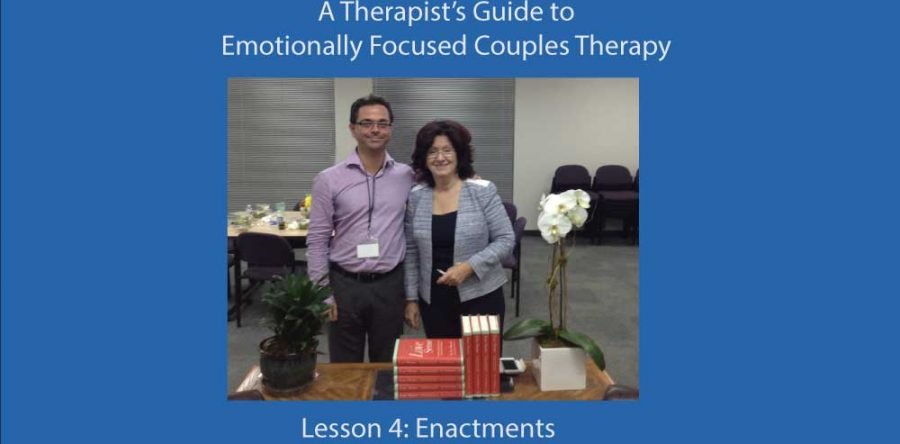Working with Enactments
In today's lesson we will looking at the concept of enactments, which are one of the main ways EFT therapists try to effect change in the way couples interact with each other.
Lesson 4: What You will Learn in Today's EFT Lesson:
- Understanding the concept of enactments and how they can help couples change their relationship dance
- Understanding the barriers to a successful enactment and how to respond when an enactment does not go as planned
Techniques Used in the EFT Method:
EFT is not just a roadmap for where we want to go, it is also a set of clearly delineated interventions and techniques that will help get us there in a way that is experiential rather than cognitive or theoretical. Most of the interventions in EFT are rooted in a humanistic or family systems framework and are intended to facilitate exploration both of a person’s subjective experience (within) and their position within the relationship as a system (between). The idea is that by changing a person’s awareness of what is happening within, they can act differently within the system, and when they act differently within the system, they produce a new experience within their partner, which in turn changes the system. Another way to say this is that by helping partners access and change the emotional music they are playing, we can help them change their relationship dance (system).
The best way to learn about the standard repertoire of EFT interventions and how they are used, is to read Sue Johnson’s chapter: Interventions in EFT (chapter 3), from Becoming an Emotionally Focused Couple Therapist - The Workbook. (72 pages)

Enactments:
A hallmark of the EFT approach is the use of enactments. What is being enacted is a new or different kind of communication from one partner to the other. Instead communicating from a reactive or defensive place, partners are helped to communicate from a place of primary emotions or attachment fears. This communication is not just voiced out loud or told to the therapist but is expressed directly and congruently to the partner from a place of feeling and sincerity. The enactment is as much about how things are stated as it is about what is stated. The person doing the enactment has to be in touch with their vulnerability and communicate from this vulnerability in order for the intended effect to be accomplished. To help the person accomplish this the therapist will follow the steps of the EFT Tango which we have reviewed in Lesson 2: 1. The therapist will validate a partner’s immediate or more surface level experience of a particular relationship situation, 2. The therapist will help the partner dig deeper to uncover more vulnerable primary emotions underneath their surface experience and reactions, 3. Once the partner is “in” the feeling the therapist will ask the partner talk to the other person from this place of what they are feeling, 4. The therapist will help the couple process both what it was like to speak from feeling and receive the feeling, 5. The therapist will help the couple see how doing things differently produced different results and how the dynamics between them have changed as a result.
Slicing the Risk Thinner:
Sometimes partners stumble when asked to pass their primary emotion over to their partner through an enactment. In these cases you can slice the risk thinner, by reducing the level of vulnerability involved in sharing. If a partner cannot say: when you criticize me I get afraid that I am going to lose you, maybe they can say: I feel too vulnerable right now to share my feelings with you, or: I get scared to tell you how I feel sometimes. Sometimes, the therapist can also help scaffold the enactment by suggestively speaking for one of the partners to role model what it might sound like. They can for example say: So right now it is too hard for you to say how much your partner really means to you and how fearful you feel sometimes that your partner will leave you? In this kind of intervention, the next best thing to having the partner share directly is accomplished by having the therapist convey the message and having the person who has shied away from turning to their partner nod or agree affirmatively.
Catching the Bullet:
Another caveat with enactments is that a partner can dig down into how they really feel and can turn to their partner to share this, but can be rebuffed or still be met with defensiveness from the listener. In these cases, the EFT therapist tries to catch the bullet, which means that they intervene with the listener to help manage the interaction in a way that does not lead to the conclusion that it was a mistake to be vulnerable or to share. One way to do this is to use parts language and to work with the part of the listener that feels self-protective or incredulous, and the part of the listener who is hearing something new and different that they ideally would like more of. The EFT therapist, might for example say: “A part of you does not trust this new message you are hearing from your partner and tells you don’t trust it, but is there another part of you that likes what you are hearing?”.
Learn More about Enactments:
To read more about the intricacies of setting up and working with enactments, read EFT trainers Tilley and Palmer’s article: Enactments in EFT (Tilley/ Palmer), pp. 1-17
You can also watch some of the following videos:
EFT in Action:
Let’s continue watching Rebecca Jorgensen’s therapy with Sandra and Carl (focus on session 2; start at: 1 hr 22 min).

At the start of session 2 Sandra is emotionally activated following her perception that Carl does not really care and is not really available to help her deal with her stress about not knowing if her son is okay during a storm. Carl tip-toes around Sandra and is acutely aware of the danger involved for him when Sandra is unsettled and seems to expect something from him. His way of coping with this uncertainty is to go quiet, make himself small, and hone in on any sign that indicates that Sandra is not happy. When Sandra does not come to bed with him as usual he knows something is up and this is distressing for him. At the same time Sandra is wondering why Carl is so concerned with her not coming to bed and construes this as a sign that he is overly preoccupied with himself. In the meantime, she feel abandoned in her hour of need and frustrated that Carl is not more proactive in checking up on her. She deals with her disappointment and her attachment fear by showing her frustration in her actions and deeds (such as not going to bed as usual), but this activates Carl’s attachment fear that he is trouble and makes him become more quiet and inward. The couple is in other words acting out their negative cycle and are stuck in fearful positions that only make it worse for the other person.
Practice Tips and Reflection Questions:
- Notice how Rebecca works with the conflict and each partner’s stuck position by helping them track the steps in their cycle and using the EFT tango to zero in on an interaction, excavate primary emotions they are not in touch with, and set up enactments to try to change their positions in their dance
- Try to fill out each step of the cycle by using the infinity cycle worksheet: What is the cue Sandra is reacting to in Carl that triggers her negative interpretations and her frustrated behaviors? What fear does Carl’s withdrawal trigger in Sandra both in terms of the relationship and in terms of how she views herself? What does she really need to feel or know deep down? How does she deal with her fears? How does Carl respond to Sandra’s way of dealing with her fears? How does he interpret her behaviors? What fears about the relationship and about himself does this interpretation invoke in him? What does Carl really need from Sandra in order for his fears to be assuaged and for him to feel safe to engage with her?
- Which EFT interventions do you notice Rebecca using?
- How does Rebecca repair misattunements between herself and the couple?
- Sandra gets in touch with fears about self and others (which is the focus of step 5). This is likely new information to Carl and helps Carl understand Sandra’s reactions better. However because this is stage 1, Carl still hears these fears as an indictment of him, and is therefore not able to be empathically attuned and responsive to Sandra’s fears. This is a good example of what distinguishes the work with emotions in stage 1 and stage 2. In stage 1, fears and primary emotions are touched on and passed on to the partner through enactments, but the partners is still responding from their own position within the negative cycle, and are not able to see or step back from cycle. Only when partners have understood all the puzzle pieces of their cycle and have been able to integrate the new information about their partner’s fears, needs, and primary feelings into a new bird’s eyes perspective of their cycle, do they have the wherewithal to step outside it and truly be present to their partner’s pain. This ability to be other-focused rather than self-preoccupied is one of the key markers of the change event of cycle de-escalation, and heralds a transition to stage 2, which will be described more in our next two lessons.
- Notice the pacing of the session: Rebecca is not rushing ahead of the clients and yanking them with her to reach the conclusions she has already surmised. She may go one step ahead of them, but not two. She follows the mantra that going slowly gets you there faster.
Stay Tuned for the Next Lesson:
Follow us for the next part of our guide to EFT therapy when we explore the subjective experience and psychology of "the pursuer". The unhappy pursuer and their unmet needs is often the reason why couples come to therapy and it is therefore crucial that we better understand how we can help couples address fears and longings that lie buried under their discontent


























